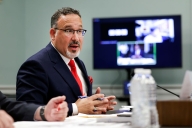You have /5 articles left.
Sign up for a free account or log in.

Nuthawut Somsuk/iStock/Getty Images Plus
An academic career can be viewed as composed of different phases, and this article is about the last one: a scholar’s later years, perhaps 60-plus. Depending on the circumstance, mandatory retirement is no longer a policy, and it is possible for a faculty member to continue being a valued contributor to the community into their 70s and possibly beyond. This period can be a time to take risks, share and contribute in different ways than during earlier phases.
Yet many faculty members—and institutions—haven’t approached an academic’s professional life cycle that way. Too often, it is one-size-fits-all.
I suggest, however, that both faculty members and higher education institutions explicitly address the different needs and goals of the latter phase of academics’ careers, just as they do with junior faculty members after they complete their graduate studies. For example, when assigning tasks and setting performance expectations, we often account for the fact that it’s the beginning of a junior faculty member’s career—acknowledging that they are novices on the job and their skills and abilities will mature over time. But how often do we do take such a tailored approach with our longer-serving faculty members?
Sometimes, those faculty members have been fortunate enough in their careers to have received opportunities to undertake different activities, learn different skill sets, take paths less traveled and have their work recognized as game changing—or possibly even redefining a field. They are the lucky ones. By the time they reach their later years, they’ve already created a legacy and made significant contributions to the main body of research in their discipline. Or they might have made other kinds of contributions beyond the traditional peer-reviewed publications.
Yet other faculty members might reflect upon their careers and want to totally change their game and leverage their knowledge, experience and wisdom in ways they haven’t been able to before. In addition, when viewed over the long haul, the influence of a senior scholar’s body of work could exceed the sum of its parts but might have to be shared with others differently for that to be realized. That person might have a backstory that could inspire and provide insights to others, especially younger faculty members—narratives that are difficult to include in traditional publications. Some academics might have developed expertise in other fields as well, yet the focus on publishing in one’s dominant field has not allowed them to share it. In other cases, such as the applied sciences, a more seasoned scholar might be able to come up with other types of breakthroughs to move their field forward or to help their community or the broader society.
How to capture these magical bits of a long career, which, in fact, might have even more impact than just the ones associated with the traditional publications?
Unfortunately, some institutions have barriers that discourage or prevent long-serving faculty members from realizing their potential for exploring new areas and educating others. There are often many incentives and pressures to stay the course and maintain the status quo: entrenched structures and expectations about funding, student supervision and research dissemination, not to mention merit reviews and a culture in which people are often compared to other members of the department. The established organizational structure and culture of academe can encourage those faculty members to keep doing the same thing year in and year out.
But imagine for a moment if the barriers did not exist. What new approaches might a faculty member consider?
For example, some long-term scholars should have the chance to conduct higher-risk research, perhaps of a longitudinal form not always possible within the traditional structures, time frames and reward systems of academe. This preliminary and exploratory work could take advantage of the scholar’s accumulated career knowledge and experiences, not to mention their long-established and expansive network of colleagues. Undertaking such longer-term and larger research agendas could have a higher potential for breaking new ground and solving new problems.
Someone with the suitable skills and expertise could also make use of the wisdom they developed over the years by:
- Working with other senior academics in multidisciplinary teams to learn with others and tackle big questions without worrying about publications and funding.
- Working with practitioners to see how the research results can actually be applied and provide value in the greater context—improving life for students, staff and faculty in their institution and at others, perhaps worldwide.
- Translating and transforming their research results and insights into suitable outputs for not only practitioners and other researchers, but also larger audiences and the general public.
Long-serving scholars also can educate others in their department or the larger institution about what they have learned about service, teaching and research. That could take the form of mentoring, coaching or workshops and the like. The sharing of their knowledge about how academe works, the mistakes to avoid and how to be effective and efficient as an academic can be invaluable. At many colleges and universities, this usually happens in ad hoc way or, again, within the traditional grad student framework.
Institutions can be more creative and productively support and channel such sharing by long-serving faculty. A department could be forthcoming and offer active support to those who want to pursue initiatives that don’t conform to the usual institutional or department norms and expectations by:
- Providing the equivalent of a starter grant to help fund new and higher-risk research. It is possible that the faculty member can find alternative funding, but that should not be assumed.
- Relaxing traditional expectations for student supervision; the traditional norms work well for incremental and derivative work within a self-regulated setting but do not accommodate roads less traveled. Time must be found for the faculty member to explore and share.
- Reconsidering annual metrics for research and publications. For example, what value is derived not only by the institution and the field but also by society in general? Are people using the academic results? Valuing them? The department might not have the necessary knowledge and expertise to make such broader evaluations and might have to seek advice from outside.
- Taking a proactive stance on risk and results. Often knowing what not to do, and why things fail, is a solid contribution—in fact, in new fields, it’s perhaps more valuable than research that works. Research productivity needs to be redefined if high-risk efforts and innovation are to be achieved.
In summary, the later years of a faculty member’s career can be a time of sharing, revelation and discovery, bringing a deep sense of fulfillment. They can provide such faculty members an opportunity to sit back and capture the essence of their work, to leverage the wisdom gained in new ways, to explore high-risk research without the stress to meet established expectations of success. The community—indeed, our society in general—deserves to hear and learn from those faculty, who should be supported in their exploratory journeys.








